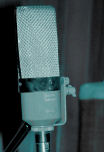 Self-recording artists often focus mainly on the instruments in a mix, and pray the vocals will somehow take care of themselves. This is understandable, as many of us started our learning on guitar and keyboard, so it’s these instruments we’re most comfortable mixing. For a guitar player, vocals are sometimes a necessary evil, rather than a core element of the music.
Self-recording artists often focus mainly on the instruments in a mix, and pray the vocals will somehow take care of themselves. This is understandable, as many of us started our learning on guitar and keyboard, so it’s these instruments we’re most comfortable mixing. For a guitar player, vocals are sometimes a necessary evil, rather than a core element of the music.
But as producer of your own songs, you need to concern yourself with all aspects of recording, especially vocals, since listeners tend to hear the singer’s voice first and foremost. While the instruments are obviously important, to really impact on your listeners, you need the vocals to stand out.
If yours sometimes fall short, the tips below can bring new life to your vocal tracks:
Don’t hold back: Can you let loose when you’re singing, or do you need to restrain yourself? If you’re concerned about waking family or neighbours, or if you’re simply self-conscious about how your voice sounds, you’ll have a hard time delivering a vocal with passion. No singer sounds good constricting her vocal cords for fear of offending the landlord.
You should feel unencumbered in your recording space, free to create and explore possibilities. So if you worry about disturbing others, consider shifting your schedule and recording with fewer restrictions. For example, record on Sunday morning when the neighbours are at church and the kids are at soccer.
Double-track: This is a tried and true method for thickening a singer’s tone. Listen to any of The Beatles’ later records for classic examples of double-tracked vocals. And fortunately, you don’t need Paul McCartney’s voice to get good results with this technique.
For best effect, record the vocal twice to separate tracks, as opposed to copy-and-pasting a single take to two tracks (which simply makes the vocal louder without altering its character.) Practice before hitting record, too, so both takes are tight, especially in the “S” and “T” sounds, or it will be obvious that you’re singing along with yourself.
Back off the mic and sing louder: Sometimes, a little more energy is all it takes to liven up a vocal. Give yourself some space, and really belt it out.
Know the top of your range and hit lots of notes just below your “breaking point.” For example, if your voice breaks at A-flat, try writing songs in C or G, so you can reach for the high G, just shy of your upper limit.
Singers who lack confidence find a comfort zone in their middle register and stay there. If you want your vocals to stand out, you need to stretch yourself a little. There are exceptions, of course: Leonard Cohen would sound ridiculous going for high A. But it’s a safe bet he knows his breaking point, and when to push it.
Sing early in the day: Your voice changes in character throughout the day, as you stress your vocal cords talking and singing. If you usually record in the afternoon or evening, you might find the subtle edge on your morning voice brings your recordings to life.
Be careful with this approach, though, and avoid singing too hard when you’re not warmed up.
Combine recordings made at different times: You can create an interesting vocal track by combining vocal takes recorded at different times or in different sessions. For example, try recording a song’s verses with your croaky morning voice, and the choruses when you’re fully warmed up. Or if your voice gets a little hoarse after singing for while, try blending takes made with your “clean” voice, and your more stressed dirty voice. The contrast in parts can give your singing a distinctive tone.
Compress heavily: It’s easy to over-compress and squash a track lifeless. But in the right situation, heavy compression can really thicken the sound of your voice.
As a starting point, try a ratio of 5:1 or more, and set the threshold so even the quietest parts of the track are compressed. And for an example of what heavy compression can do for a vocal, listen to the samples in the best free vocal plugins article.
Tone down the backing tracks: If your voice sounds weak or ineffective in a mix, consider that it might be the mix, rather than your voice, causing problems. Not every voice suits every arrangement – for example, imagine Paul Simon singing with Nirvana. If your voice is closer to Paul’s than Kurt’s, you should allow for this in your mixes. Relax the aggressive tones, and work on arranging the instruments so your voice has space to sound natural.
Hopefully it goes without saying, but these tips aren’t appropriate for every song you record. However, if you’re unhappy your vocal on a particular track, one or two of the tricks above might yield the inspiration you need to nail the recording.
For more articles on recording great vocals,
subscribe to the Hometracked feed.
Tags: vocals


3 comments
Trackback URI Comments feed for this article